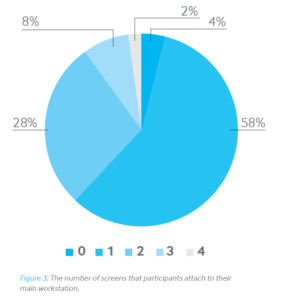We spoke in a telephone interview with Phil Gaut of Samsung UK about the recent release of the firm’s curved desktop monitors (Samsung Brings its Curve to Europe)
These were launched a couple of weeks ago with the support of a document endorsed by Prof. Stephen Westland, Professor of Colour Science at the University of Leeds in the UK. The document summarises a recent survey by Samsung, conducted in the UK, of 2,000 office workers in a variety of industries during a single week in March this year. No details were provided on how recruitment was done.
The survey found some interesting data. 38% of those that responded already use dual screens. On average, they spend 22 minutes on a task before being interrupted, typically by checking email, but also by noise and other workers. A slightly depressing statistic, at least for employers, is that they estimate that on average they get something done on only 3.6 days in the week. (Although having had a day like that on Tuesday, last, when I started with a list of objectives for the day and had none of them done after a very busy day, I can understand this comment! Man. Ed.)
Larger displays clearly help with productivity, with less time spent switching and resizing windows, and the paper supports the idea that one curved display produces “less eye strain” than a single large flat display.
The study also focused on the idea that a curved display could provide a more immersive experience, with a consequent reduction in distractions, which were cited by respondents as an issue in being as productive as possible.
The survey also asked about the importance of “good aesthetics” in the workplace – Samsung sees its designs as more attractive than the more utilitarian designs, especially those from the major PC makers.
Gaut was in a bullish mood when we spoke to him. Samsung has been successful in winning a 500 display project for a transport company for the company’s new 27″ curved display following a full evaluation against flat and competitive alternatives. That’s a good start for the push on the technology.
He believes that distribution channels are more and more interested in consolidating the monitor ranges that they will promote, so he expects the top brands to take an increasing share as we go forward.
Analyst Comment
I was interested that the study thought that there might be a reduction in eye strain as a result of using a curved display. No direct evidence is given. There are also comments that the viewer is orthogonal to the screen, improving performance, with a curved display. In practice, at the current radius of curved monitors, the reality is that while viewing angles are better than with a flat display, they may, or may not be better than dual displays, if those displays are angled apart and the view is certainly more orthogonal than with a flat display.
Still, it’s good to see Samsung at least trying to get some data to endorse the idea of curved displays. We thought that the penetration of dual or more displays at 38% is a really positive sign for the long term monitor market. (BR)

